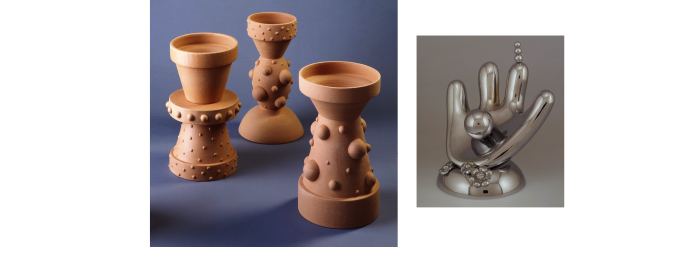This is the final installment of Chris Pullman's series on his friend Dan Firedman, who was awarded the AIGA Medal this week in New York City. The entire series can be found here.
++
Despite a remarkable outpouring of work, Dan remained uncategorizable: “too three-dimensional for graphics publications," wrote Steven Holt, "too arty for design publications, too free-form for crafts publications, and too functional for art journals.”
++
Despite a remarkable outpouring of work, Dan remained uncategorizable: “too three-dimensional for graphics publications," wrote Steven Holt, "too arty for design publications, too free-form for crafts publications, and too functional for art journals.”
He may have been more widely known in Europe than in his own country. In Italy, for example, his work attracted the attention of the Memphis Group, who, in the early 1980s, they began to produce sensual, highly decorative and zany objects. One journalist wrote that the Memphis designer thinks of design “as a semantic event, charging an object with [cultural] information, making it a metaphor … an active presence rather than a dull opaque support for functions.” It’s easy to see how Memphis would embrace Dan’s work and attitude.

Left: Memphis; right: Dan Friedman, including the blue Zoid sofa
Dan went on to execute a number of commissions in Italy, like his shiny "Handoid" and a series of playful flower pots, and in Paris, in the ’90s, Gallery Neotu issued several editions of his furniture, including the funky Zoid sofa.
Dan went on to execute a number of commissions in Italy, like his shiny "Handoid" and a series of playful flower pots, and in Paris, in the ’90s, Gallery Neotu issued several editions of his furniture, including the funky Zoid sofa.

As Dan transformed himself through the ’80s, our relationship with him gradually transformed as well. Paradoxically, as he became outwardly more and more different from us, our connection grew more and more familiar. This is when he began to visit us in Annisquam, MA, with regularity. He was an exotic presence in this staid, old-fashioned place, decked out in his pink high tops and Budweiser hat. He seemed to love it there, hanging out on the porch, watching the sunset. I think his own great adventure into the art scene, while exhilarating and productive, was also exhausting and dangerous, and this place offered a respite.

What set Dan apart, and accounts for his diverse but coherent body of work, is that he pursed an approach not a style. “An approach,” wrote Steven Holt, “is a series of investigative questions one asks during the design process, whereas a style is a series of similar-looking answers to whatever question is being asked." Dan’s approach was based on a conviction about the bedrock values of modernism and its appropriateness to—or perhaps especially to—today's world.
What Dan saw in the ’70s was that designers were obsessed with modernist form for its own sake, detached from its original social engagement or philosophical underpinnings. Modernism, he lamented, sacrificed its claim to moral authority when designers began to sell it as corporate style.

So Dan, whose experiments had taken him from student to teacher to corporate designer to hip-hop groupie to international designer/artist, struggled through this period to reconcile his own personal experiences with the original pro-social, positivistic origins of modernism that were so crucial to his world view. “Many of us,” he wrote, “attempted to reevaluate traditional modernist ideas while introducing, within their framework, diverse culture, history and fantasy.”
Near the end his life, he summed up this reconciliation in his book. In it he offers an updated version of modernism, founded on its original philosophical heritage, but accommodating a more inclusive and expressive formal language that reflected the exhilarating, chaotic, unpredictable, and dangerous reality he experienced near the end of the century.

Not only do I find his formulation compelling, I also admire how, in the face of tremendous personal uncertainty, he was able to produce such a thoughtful book, along with its companion traveling exhibit, which together are a wonderful record of his profuse professional life. In Radical Modernism he formulated a kind of unified field theory of design that on the one hand helped explain—or perhaps even justify—his amazing life, and on the other hand offered a new, practical and optimistic future for design and for culture.
Friedman’s life and work reflect not only his impeccable formal standards, but also an exquisite attention to philosophical and ethical values that are more relevant than ever in the contemporary design profession. His recognition as an AIGA Medalist provides a poignant reminder of how his ideas and advocacy have enlarged our understanding of what design can be. His eclectic, evolving career offers an intriguing model for a practice that can be far more open, culturally relevant, and self-directed.
At the end of his book he offers a twelve-point manifesto, as wise and optimistic today as it was twenty years ago:
—Live and work with passion and responsibility; have a sense of humor and fantasy.
—Try to express personal, spiritual, and domestic values even if our culture continues to be dominated by corporate, marketing and institutional values.
—Choose to be progressive: don’t be regressive. Find comfort in the past only if it expands insight into the future and not just for the sake of nostalgia.
—Embrace the richness of all cultures; be inclusive instead of exclusive.
—Think of your work as a significant element in the context of a more important, transcendental purpose.
—Use your work to become advocates of projects for the public good.
—Attempt to become a cultural provocateur. Be a leader rather than a follower.
—Engage in self-restraint; accept the challenge of working with reduced expectations and diminished resources.
—Avoid getting stuck in corners, such as being a servant to increased overhead, careerism, or narrow points of view.
—Bridge the boundaries that separate us from other creative professions and unexpected possibilities.
—Use the new technologies, but don’t be seduced into thinking that they provide answers to fundamental questions.
—Be radical.



Comments [1]
05.18.15
05:45